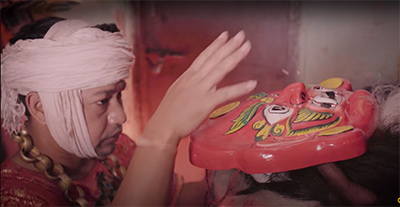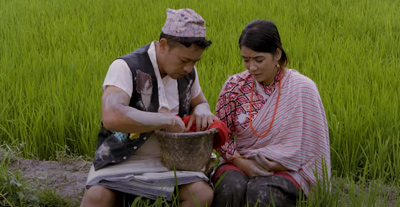
Lakhey Dance
Lakhe Dance is the popular ancient performance being practiced among Newar communities mostly in Kathamndu valley and across Nepal which is still going strong. It is believed that negative energy is eased out when Lakhey dance is performed across streets and corners of habitats. Lakhey is considered to be the holy guard. Hence it is the important reason to bring him out once a year. Primarily, Lakhe Dance is celebrated between Gatha Muga: and Indrajatra. However, depending upon locality, society and rituals, the event is practiced in own musicals, style and schedule as well.
The tune that we have used in this video is played in various parts of Kathmandu valley. As the Lakhey Dance practice has variance in many ways, we have tried to show the traditional Lakhey performance of Lubhu, Lalitpur. In addition, flame hitting as the climax of performance is inspired from Lakhey Dance of Siddhipur, Thasi, Lalitpur.
The social belief that negative energy is swept away by Lakhey has been symbolized in our video through dramatic interpretation which shall just be a coincidence if matched in anyone's life.
For the musical instrument side, Pachima musical style of Kathmandu and Lubhu style of Dha: and Khi: has been used. We hope, as always, our audience will appreciate our effort to showcase the reality behind this ancient ritual practice of winning of positive power over negative energy.
The Chaka played in the beginning of Cho: Taal 4/4 has been composed by Bipu Shrestha for the Lakhey Dance of Lubhu which is in practice currently during the occasions.
Click here to view the video of Lakhey dance

Tukaa Jya
‘'Tukaa Jya'’ is a Newa seasonal tune (song) which is been playing continuously from ancient period till date in Nepal. While ‘'Sina Jya'’ is played during the rice plantation festival, ‘'Tukaa: Jya’' is played while removing bushes that grows in between rice plant after plantation. Typically a Newar term, "tu" means tiny bushes that grow in between the rice plant, "kaa" means to take away and "jya" means task. So, "Tukaa: jya" means a task to take away the bushes that grow in between the rice plant.
This is very emotional song of a farmer couple, who had faced lots of sorrowful moments in the rainy season, they are passing through. The musician and lyricist had expressed those sorrowful moments of their life in this very popular and emotional tune (song) of Newa community.
PANCHA KAPAL
"Pancha Kapal" is a rare form of Mahakala which is generally worshipped by the genuine practitioner in Vajrayana Buddhism. "Pancha" means five and "Kapala" means skull and as name suggests he is the protector deity with five skull in his crown.
Mahakala is worshipped by both the Hindu and Buddhist followers in kathmandu valley. Buddhist practictioners worship him as the wrathful protector and representation of the passion and energy of Avalokitesvara where as Hindu followers worship his as a wrathful form of Lord Shiva.
Mahakala is seen sitting on the corpse as he is believed to be greater than the time and death. As the name suggests, "Maha" means greater and "Kala" means death or time.
SILU DHOON
It is said that if a married couple go to Silu Tirtha ( Gosai Kunda), they will be separated.This song/ Melody ( Dhoon) describes a emotional situation when a husband is going to Silu tirtha alone but his wife wants to go together.
Sina Jya
"Sina Jya" is a melody which is sing and play during plantation. Sina Jya is one of the jolly melody in the barah mase dhun. The barah dhoon was originated in the Newar culture before many century. The Sina Jya song and tune is sung and play in the month of Ashad. It is a traditional dhoon (song) which is still very famous among the Newar community.
Dhanashree
"Dhanashree" is the mixture of two words 'Dhana' and 'ashree' which means goddess of wealth aka goddess Laxmi. Dhanashree is one of the major dhoons in the barah dhun. The barah dhoon was originated in the Newar culture before many century. The dhanashree song and tune is sung and play in the month of Kartik and Mangsir after the Newari farmers finish their harvest. It is a traditional dhoon (song) which is still very famous among the Newar community.
Color Blind
"Color Blind" is the historic collaboration between popular singer Robin Taman, legendary guitarist Hari Maharjan and Project Baja Nepal. The song has been created for 2567 Buddha Jayanti at Mayur Varna Mahabihar, Bhinchhebahal, Lalitpur
HOLI EAST AND WEST
Holi, a popular ancient festival of colors celebrates arrival of spring season, end of winter on the day of full moon, Falgun month according to Nepali calendar (BS) every year. The festival gets started by erecting pole called “Chir” with various colorful flags around on the day of “Astami”, eight days before at Kathmandu Durbar Square, Basantapur.
In Nepal, people are diversified based on topography landscape into different culture, cast, language and religions. Allover Nepal, People celebrates by splashing different colors, waters and sings their traditional and ethnical songs with families and friends.
Similarly, to prevent and flourish tradition, culture practice with the means of songs, We are trying in collaboration with renowned singers, musicians, artists, ethnical groups and organizations to successfully publish the music video.
Basanta
In this Basanta's video, we have included the spring songs that have been sung in Nepal Mandal since time immemorial and are now being created.
The song 'हे हे माधव वियमते नुगलया धाल (Hey Hey Madhav Viyamte Nuglaya Dhal )' is a very old Basanta song in Raga Basant and Taal Jati (7/8 beat), and its exact origin is uncertain.
Following that, there's a popular Basanta tune in Bhaktapur based on Raga Basanta and Taal Cho (4/4 beat), featuring songs dedicated to various gods and goddesses.
The song 'श्याम सुन्दर बसन्तया बेलसं राधा व म्हितल वन' (Shyam Sundar Basantaya Belsan Radha and Mhital ban) is in Raga Basanta Tal Cho (4/4 beat) and describes Radha Shyam's joyful time in Vrindavan. Its composer and creation date remain unknown.
The song 'हादे छिके विनती खँ ल्हाय सरस्वती माजु (Hade Chhike Binti Khan Lhay Saraswati Maju)' is popular in Nepal Mandal. It prays to Goddess Saraswati for education excellence, emphasizing her as Vageswari. It contains the secret mantra 'Na mo Va ge swa ra ya' and is typically sung with a focus on this mantra. Associated with Chhatra Pati King Ranjit Malla, its creation date remains uncertain.
After that, the melody of the Newari popular Basanta song 'Siri Siri Fasan Jitah Kuchu Kuchu Nakala' and finally the Newari song 'Hakan Chak Hawa Re Jhangacha' have been included.
Malashree Dhun
Malshree Dhoon (Nepal Bhasa: नेपाल भाषा ) is a Newa artform in which musicians perform devotional music. It is the tune that announces that Dashain, the biggest Hindu festival of Nepal, has arrived. The Malshree dhoon originally belongs to the Newari culture from the Kathmandu valley, and it’s a folk music of Newari cultural.
Click here to view the Malashree Dhun

